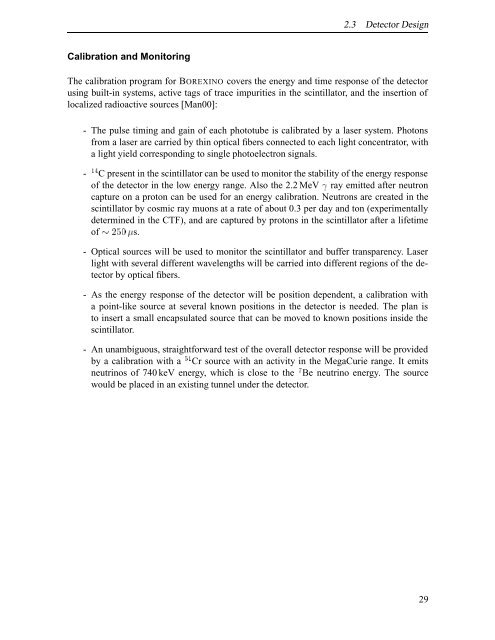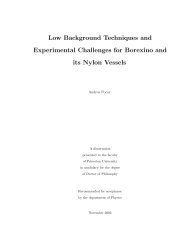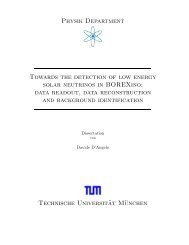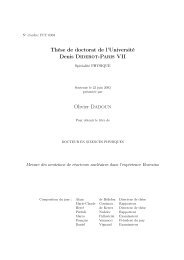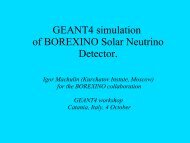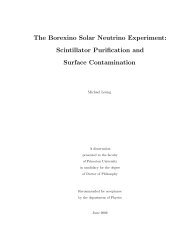Development of a Liquid Scintillator and of Data ... - Borexino - Infn
Development of a Liquid Scintillator and of Data ... - Borexino - Infn
Development of a Liquid Scintillator and of Data ... - Borexino - Infn
Create successful ePaper yourself
Turn your PDF publications into a flip-book with our unique Google optimized e-Paper software.
Calibration <strong>and</strong> Monitoring<br />
2.3 Detector Design<br />
The calibration program for BOREXINO covers the energy <strong>and</strong> time response <strong>of</strong> the detector<br />
using built-in systems, active tags <strong>of</strong> trace impurities in the scintillator, <strong>and</strong> the insertion <strong>of</strong><br />
localized radioactive sources [Man00]:<br />
- The pulse timing <strong>and</strong> gain <strong>of</strong> each phototube is calibrated by a laser system. Photons<br />
from a laser are carried by thin optical fibers connected to each light concentrator, with<br />
a light yield corresponding to single photoelectron signals.<br />
- C present in the scintillator can be used to monitor the stability <strong>of</strong> the energy response<br />
<strong>of</strong> the detector in the low energy range. Also the 2.2 MeV ray emitted after neutron<br />
capture on a proton can be used for an energy calibration. Neutrons are created in the<br />
scintillator by cosmic ray muons at a rate <strong>of</strong> about 0.3 per day <strong>and</strong> ton (experimentally<br />
determined in the CTF), <strong>and</strong> are captured by protons in the scintillator after a lifetime<br />
<strong>of</strong> s.<br />
- Optical sources will be used to monitor the scintillator <strong>and</strong> buffer transparency. Laser<br />
light with several different wavelengths will be carried into different regions <strong>of</strong> the detector<br />
by optical fibers.<br />
- As the energy response <strong>of</strong> the detector will be position dependent, a calibration with<br />
a point-like source at several known positions in the detector is needed. The plan is<br />
to insert a small encapsulated source that can be moved to known positions inside the<br />
scintillator.<br />
- An unambiguous, straightforward test <strong>of</strong> the overall detector response will be provided<br />
by a calibration with a Cr source with an activity in the MegaCurie range. It emits<br />
neutrinos <strong>of</strong> 740 keV energy, which is close to the Be neutrino energy. The source<br />
would be placed in an existing tunnel under the detector.<br />
29


